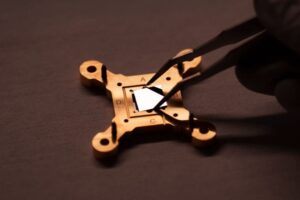In the fascinating world of avian migration, the impact of human-made radio waves on the magnetic sense of migratory birds has emerged as a subject of significant scientific curiosity and concern. This intriguing phenomenon sheds light on the complex navigational systems that birds utilize and highlights the potential consequences of human technology on wildlife.
 Pin
Pin Image by: serhii_bobyk Freepik.com
Table of Contents
Exploring Bird Navigation and Magnetic Sensing
Migratory birds are known for their incredible ability to navigate across continents, often flying thousands of miles from their breeding grounds to wintering sites and back again. Scientists have discovered that one of the key components of this remarkable navigational skill is the birds’ magnetic sense. This allows them to perceive the Earth’s magnetic field and use it as a guide.
The Impact of Radio Waves on Avian Compass
Recent studies have revealed that certain frequencies of radio waves can disrupt this magnetic sense, causing confusion and potentially hindering the birds’ ability to navigate effectively. The specific frequency range that has been identified as problematic lies predominantly in the low to middle MHz range, which overlaps with frequencies used for various communication technologies, including AM radio broadcasts.
One groundbreaking study published in the journal “Nature” detailed how researchers observed significant disorientation in European robins when exposed to AM radio frequency noise. It was found that this disruption occurred even at levels of radio noise considered negligible to human technology users, suggesting that even low levels of radio frequency pollution could have a profound impact on these migratory species.
Mitigating the Effects
Understanding the specific frequencies that interfere with the magnetic sense in migratory birds is crucial for developing strategies to mitigate these effects. This might involve regulating the use of certain frequencies or implementing “quiet zones” in key migratory pathways to ensure birds can navigate without interference. Moreover, it calls for a collaborative effort between scientists, technology companies, and policymakers to balance technological advancement with the preservation of wildlife and biodiversity.
Quantum Compass: How Birds Navigate the Invisible
In the realm of ornithology, a groundbreaking discovery has emerged, reshaping our understanding of how migratory birds conquer vast distances with precision. Scientists have long marveled at the innate ability of these avian travelers to navigate the globe, a skill underpinned by their uncanny sense of orientation. A recent study published in the Proceedings of the National Academy of Sciences (PNAS) dives deep into this phenomenon, revealing intriguing insights about the magnetic compass of migratory birds and the impacts of human-made electromagnetic fields on their navigation.
Led by Professor Dr. Henrik Mouritsen of the University of Oldenburg and Professor Dr. Peter Hore of the University of Oxford, the research team embarked on a quest to demystify how radio waves and electrosmog affect these natural compasses. Their findings illuminate a critical distinction: while the lower frequency radio waves emitted by radio and television broadcasting, as well as CB radio, can disrupt the birds’ magnetic compass, the higher frequency waves utilized in mobile communication networks do not pose a threat. This revelation not only clarifies the impact of human technology on avian navigation but also supports a broader theory regarding the nature of the birds’ magnetic sense.
At the heart of this magnetic navigation is a quantum-mechanical effect known as the radical pair mechanism, located within the birds’ eyes. This theory suggests that certain cells in the retinas of migratory birds are engaged in complex quantum-physical processes, allowing them to perceive the Earth’s magnetic field and use it as a guide. To unravel the mysteries of this quantum compass, Mouritsen, Hore, and their colleagues combined behavioral experiments with comprehensive quantum-mechanical calculations performed on a supercomputer.
Their research builds upon earlier studies, including their own work from 2014, which demonstrated that electrosmog from AM radio wavebands, like that generated by household electrical appliances, impairs the birds’ magnetoreception. This low-level electromagnetic noise interferes with the quantum processes in the birds’ eyes, hindering their ability to sense and navigate by the Earth’s magnetic field.
These findings hold profound implications for understanding the decline in numbers of long-distance migratory birds, an alarming trend that has puzzled scientists for years. By pinpointing the sources of disruption to the birds’ navigational system, the study offers a new lens through which to view the challenges faced by these remarkable creatures in an increasingly connected world.
In shedding light on the delicate interplay between biology and physics, this research not only enriches our understanding of animal navigation but also opens new avenues for protecting migratory birds amidst the growing tide of electromagnetic pollution. As we delve deeper into the quantum underpinnings of nature, the study underscores the urgent need for a harmonious coexistence with the living tapestry of our planet.
Unraveling the Mystery of Bird Navigation: The Role of Cryptochrome
Bird migration is a natural wonder, guided by an intriguing, yet not fully understood, magnetic compass sense. A groundbreaking study has brought us a step closer to unlocking this mystery, focusing on the potential quantum-mechanical roots of this navigational prowess and its vulnerability to radio wave interference. Central to this exploration is a light-sensitive protein known as cryptochrome 4, believed to be the heart of birds’ magnetic compass.
The intrigue around birds’ navigational abilities has long captivated scientists. In their quest for answers, researchers embarked on a journey to examine the effects of radio waves on this delicate sense of direction in migratory birds, particularly the Eurasian blackcaps. Their objective was clear: to establish the connection between the suspected quantum-mechanical mechanism behind birds’ magnetic sensitivity and how radio waves might disrupt it. This endeavour was not just about understanding; it was about paving the way for further research into how modern technologies could be influencing migratory patterns.
The hypothesis centred around a specific range within the Very High Frequency (VHF) spectrum: 120 to 220 megahertz. The scientists posited that this range includes the cutoff frequency – a threshold above which birds’ navigation remains unaffected by electromagnetic interference. Identifying this parameter was crucial, as it could offer insights into the characteristics of the cryptochrome 4 protein, which is believed to act as the magnetic sensor within the birds.
To test their theory, the team conducted behavioral experiments with Eurasian blackcaps, focusing on the effects of exposure to different radio frequencies within the hypothesized range. Their findings were revealing. Previous studies in 2022 had shown that frequencies between 75 and 85 megahertz disrupted the magnetic compass sense of these birds, rendering them unable to navigate effectively. However, the new experiments aimed to pinpoint more precisely how various frequencies influenced this sense, providing clearer insights into the cutoff frequency and, by extension, the nature of the magnetic sensor itself.
Eurasian blackcaps, known for their extensive migratory journeys, became the perfect subjects to understand the broader implications of human-made electromagnetic fields on avian navigation. The study stands as a significant milestone in the broader quest to comprehend the magnetic compass sense in birds, offering a foundation for future research into environmental impacts on migratory behavior.
In essence, the discovery of cryptochrome 4’s role in bird navigation not only unravels part of the mystery behind this extraordinary capability but also warns of the potential threats modern technology may pose to these crucial natural phenomena. As we move forward, this understanding heralds a new era in conservation efforts, emphasizing the need to harmonize our technological advancements with the preservation of wildlife migration patterns.
Radio Waves Above 116 MHz Have Minimal Effect on Bird Compass Sense: A Detailed Study
A groundbreaking study led by scientists Mouritsen and Hore, and featuring lead authors biologist Bo Leberecht and chemist Siu Ying Wong from the University of Oldenburg, has shed new light on the impact of high-frequency radio waves on the magnetic compass sense of migratory birds. In a focused investigation exploring frequencies between 140 and 150 megahertz and between 235 and 245 megahertz, the team has determined that these radio waves do not interfere with the avian magnetic compass sense. This finding aligns perfectly with the researchers’ initial theoretical forecasts.
Delving deeper into the biological mechanics, the team conducted model calculations to simulate the quantum-mechanical processes occurring within the cryptochrome protein, a potential agent in the birds’ navigation mechanism. These simulations pinpointed a critical cut-off frequency of 116 megahertz. Radio waves above this threshold were predicted to have only a minimal impact on the birds’ magnetic orientation capabilities. The empirical data from their experiments confirmed these predictions, reinforcing the team’s hypothesis.
The significance of these findings goes beyond the specific frequencies tested, pointing to a broader understanding of how migratory birds navigate. Mouritsen emphasized, “Our experiments, together with detailed theoretical predictions, provide strong evidence that the compass magnetoreceptor in migratory birds is based on a flavin-containing radical pair.” This suggests that the birds’ compass is not influenced by alternative receptors, such as those hypothesized to be based on magnetic nanoparticles.
This research not only enhances our understanding of avian navigation but also paves the way for future investigations into the intricate relationships between biological organisms and electromagnetic forces. It stands as a testament to the complex harmony between living beings and their physical environments, opening new avenues for exploring the mysteries of nature’s navigational tools.
Reassuring Revelation: Migratory Birds Unaffected by Mobile Network Frequencies, Study Shows
Recent findings from a diverse group of international researchers have cast new light on the impact of human-made electromagnetic fields on birds’ magnetic sense, a navigational tool critical for the long journeys migratory birds undertake. Spearheaded by the spokesperson of the Collaborative Research Centre (CRC) on Magnetoreception, Henrike Mouritsen, this comprehensive study seeks to unravel the complexities of magnetoreception—the ability of birds to perceive Earth’s magnetic field for orientation and navigation.
Magnetoreception remains one of the most enigmatic senses in the animal kingdom, with ongoing research striving to demystify how birds utilize this sense for migration. Understanding the intricacies of this natural phenomenon is crucial for the conservation of migratory birds, highlighting the need to identify which electromagnetic frequencies might disrupt their innate navigation capabilities. Areas designated for their rest, such as nature reserves, are of particular concern.
Mouritsen emphasizes a significant distinction in the impact of electromagnetic radiation on magnetoreception. Contrary to the perturbations caused by the frequencies associated with radio and television broadcasting or CB radio, the study reveals a reassuring conclusion regarding modern mobile communications networks. “The frequencies used here are all above the relevant threshold,” Mouritsen explains, indicating that these do not interfere with the magnetic sense of birds. This insight is pivotal for the ongoing deployment and expansion of mobile networks, suggesting that such technologies may coexist with migratory birds without detrimentally affecting their navigational abilities.
The CRC’s research draws on the expertise of an international team, pulling from fields such as neurobiology, quantum physics, biochemistry, computer modelling, and behavioural biology. This multidisciplinary approach not only ensures a comprehensive understanding of magnetoreception but also reinforces the importance of diverse scientific collaboration in addressing environmental and ecological challenges. Institutions such as the University of Oldenburg, Institute of Avian Research “Vogelwarte Helgoland”, Freie Universität Berlin, Ruhr University Bochum, and the Weizmann Institute of Science, along with affiliated Mercator Fellows from the University of Oxford, contribute to this groundbreaking work.
This study underscores the nuanced nature of electromagnetic radiation’s impact on wildlife, providing essential data to guide the development of bird-friendly technologies and conservation strategies. By delineating safe frequencies that do not interfere with birds’ magnetic sense, the research paves the way for harmonious coexistence between modern technology and the natural world.
FAQs
Radio waves are a type of electromagnetic radiation with wavelengths longer than infrared light. They are used for various forms of communication, such as broadcasting and mobile phone signals.
Migratory birds have a magnetic sense that allows them to navigate long distances by detecting the Earth’s magnetic fields. This ability acts like a natural compass, guiding them during their migratory journeys.
Yes, research suggests that certain frequencies of radio waves can interfere with the magnetic sense of migratory birds, potentially causing disorientation or affecting their ability to navigate.
Studies indicate that radio waves below 116 MHz (megahertz) have a more significant impact on the magnetic compass sense in birds. Frequencies above this threshold seem to have minimal effect.
Potentially, yes. If birds rely on their magnetic sense for navigation during migration, interference from radio waves could disrupt their routes, leading to increased energy expenditure or even the inability to reach their destination.
The sensitivity to radio wave interference can vary among different species, with some being more affected than others. Research is ongoing to understand the specific impacts on various species.
Mitigation strategies could include regulating the use of certain frequencies during critical migratory periods or implementing buffer zones around key habitats to minimize exposure to disruptive frequencies.
Yes, the study of how human-made electromagnetic fields impact wildlife, including migratory birds, is a growing field of research. Scientists are continuously exploring the extent of these effects and potential solutions to mitigate adverse impacts.
Several scientific journals and organizations dedicated to wildlife conservation and bird migration research publish findings on this subject. Websites of entities like the Audubon Society or the Cornell Lab of Ornithology can be good starting points for updated information.


































